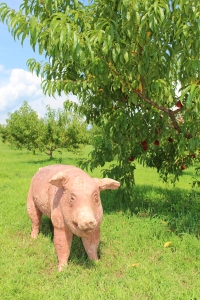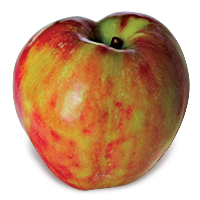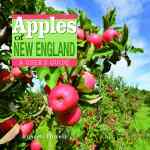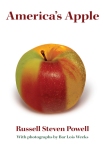

MANY HEIRLOOM APPLES have one or more flaws that keep them from mass cultivation. It may be that the variety is biennial, producing crops every other year, or is otherwise an unreliable “cropper.” The apples may be small or misshapen.
Some otherwise fine apples do not make it to the marketplace because they do not store or ship well. Some apples simply fall out of fashion, notably the once popular russets, with their brown and copper colored skin and rough, sandpaper-like skin.
The flavor of some heirloom varieties is too bland to compete with today’s commercial apples. The virtues of some apples do not translate well from their native climate, geography, and soil, losing distinctiveness when grown on a mass scale.
Some apples pose horticultural challenges, susceptible to certain pests and disease, dropping fruit before it is ripe, or vulnerable to extremes of weather.
The owner of a commercial orchard cannot afford large plantings of rare or obscure apples that may be difficult to grow, fail to produce, lack distinction, or cannot compete in the marketplace. Yet on a small scale and in the right circumstances, many heirloom apples continue to flourish, broadening our experience of this incredibly diverse fruit.
The apple is ancient, but constantly reinventing itself. Heirlooms are unique, edible relics from earlier times, exact replicas of the fruit from their original tree. The best of these are not just historically significant, they add a range distinctive colors, shapes, flavors, and textures to the eye and palette.

It is safe to say that if an apple has been cultivated for 400 years, it must have something going for it. Such is the case with Gravenstein. Its limitations as a commercial apple are mostly horticultural, especially its vulnerability to extreme cold. Its obscure, old-fashioned name is a liability in today’s marketplace, and it does not store or ship as well as some varieties due to its thin skin.
Yet Gravenstein is beautiful to behold and excellent for both cooking and fresh eating. It is a medium-sized apple with a blunt, conical shape, more barrel-like than the taller, slender Red Delicious. Gravenstein’s mix of reds and light greens blend together in an unusual watercolor wash. Its white flesh is crisp and juicy, and its flavor is lemony tart.
Gravenstein inspires an almost cult-like devotion in some people, who consider it to be the best single variety for an apple pie. They will drive miles to get their hands on Gravensteins when they learn of a supply. It is fruitless to argue with these enthusiasts, especially early in the season, since Gravensteins ripen before such leading pie-apple contenders as Cortland and McIntosh, Mutsu and Northern Spy.
Gravenstein’s parentage and origin are unknown, but it is believed to have come from Germany or Italy, dating back to at least the 1600s. It has been popular in Denmark since it first arrived in the southern town of Gråsten in 1669, and it was named Denmark’s national apple in 2005. Gravenstein is the German name for Gråsten.
Gravenstein migrated to England in 1819, and to the United States in the 1820s, possibly as one of several apples imported here by the Massachusetts Horticultural Society. Gravenstein became popular in New England in the late 1800s, and it was the fifth most widely planted apple in the region as recently as 1930, trailing only Baldwin, McIntosh, Red Delicious, and Wealthy.
Gravenstein’s decline was hastened by the same harsh winter in 1933-34 that wiped out most of New England’s Baldwin crop. Gravenstein remains a hard-to-find heirloom in New England today, but it is still grown widely in parts of Europe and the United States, especially in California.
Red Gravenstein is a sport variety of Gravenstein, meaning that it resulted from a mutant limb rather than seed. As its name suggests, it is redder in color than its parents, and a little less tart. It was first cited in 1873.
* * *


About 1,000 people attended the opening of the third Art In The Orchard, a biennial outdoor sculptural exhibit at Park Hill Orchard in Easthampton, Massachusetts, Saturday, August 15. The walking orchard tour features the works of nearly 30 artists from around New England, whose sculptures are nestled throughout the farm, in and among the apple trees. The sculptures will remain on view through October 15.
* * *
TWO RECENT BOOKS by Russell Steven Powell, senior writer, and Bar Lois Weeks, executive director of the New England Apple Association, explore the history of apple growing in the region and look at the nation’s apple industry.
 Apples of New England (Countryman Press) is an indispensable resource for anyone searching for apples in New England orchards, farm stands, or grocery stores — or trying to identify an apple tree in their own backyard.
Apples of New England (Countryman Press) is an indispensable resource for anyone searching for apples in New England orchards, farm stands, or grocery stores — or trying to identify an apple tree in their own backyard.
The book contains color photographs by Weeks and descriptions of more than 200 apples discovered, grown, or sold in New England, accompanied by notes about flavor and texture, history, ripening time, storage quality, and best use. Apples of New England offers practical advice about rare heirlooms and newly discovered apples.
Apples of New England includes chapters on the rich tradition of apple growing in New England, and on the “fathers” of American apples, Massachusetts natives John Chapman (“Johnny Appleseed”) and Henry David Thoreau. Apples of New England presents the apple in all its splendor: as a biological wonder, as a super food, as a work of art, and as a cultural icon.
 America’s Apple (Brook Hollow Press) tells a rich and detailed story about apple growing in America, from horticulture to history to culinary uses. Powell writes about the best ways to eat, drink, and cook with apples. He describes the orchard’s beauty and introduces readers to some of the family farms where apples are grown today, many of them spanning generations.
America’s Apple (Brook Hollow Press) tells a rich and detailed story about apple growing in America, from horticulture to history to culinary uses. Powell writes about the best ways to eat, drink, and cook with apples. He describes the orchard’s beauty and introduces readers to some of the family farms where apples are grown today, many of them spanning generations.
America’s Apple looks at how America’s orchards are changing as a result of the trend toward intensive planting and the trademarking of new varieties, and what that means to consumers. Powell also writes about the fragile underpinnings of modern agriculture: the honeybees needed to pollinate the crop and the labor required to pick it, plus new and exotic pests and increasingly volatile weather.
Apples of New England and America’s Apple are available in hardcover at fine bookstores and orchards and online. America’s Apple is also available in paperback.
For more information, write to newenglandapples@verizon.net.